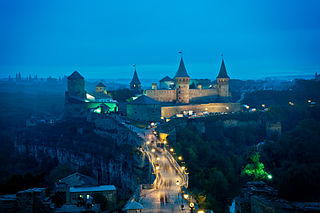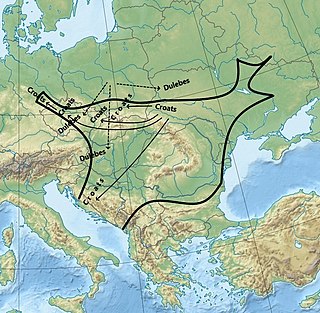Related Research Articles

The East Slavs are the most populous subgroup of the Slavs. They speak the East Slavic languages, and formed the majority of the population of the medieval state Kievan Rus', which they claim as their cultural ancestor. Today, the East Slavs consist of Belarusians, Russians, Rusyns, and Ukrainians.

Podolia or Podilia is a historic region in Eastern Europe, located in the west-central and south-western parts of Ukraine and in northeastern Moldova. The name derives from Old Slavic po, meaning "by/next to/along" and dol, "valley".

The Drevlians or Derevlianians were a tribe of Early East Slavs between the 6th and the 10th centuries, which inhabited the territories of Polesia and right-bank Ukraine, west of the eastern Polans and along the lower reaches of the rivers Teteriv, Uzh, Ubort, and Stsviha. To the west, the Drevlians' territories reached the Sluch River, where the Volynians and Buzhans lived. To the north, the Drevlians' neighbors were the Dregovichs.

The Tivertsi, were a tribe of early East Slavs which lived in the lands near the Dniester, and probably the lower Danube, that is in modern-day western Ukraine and Republic of Moldova and possibly in eastern Romania and southern Odesa oblast of Ukraine. The Tivertsi were one of the tribes that formed the Ukrainian ethnicity, namely the sub-ethnic and historic region of Podolia. The Tivertsis' cultural inheritors, the Podolians, are a distinct group of Ukrainians.

The Przeworsk culture was an Iron Age material culture in the region of what is now Poland, that dates from the 3rd century BC to the 5th century AD. It takes its name from the town Przeworsk, near the village where the first artifacts were identified.

The Zarubintsy or Zarubinets culture was a culture that, from the 3rd century BC until the 1st century AD, flourished in the area north of the Black Sea along the upper and middle Dnieper and Pripyat Rivers, stretching west towards the Southern Bug river. Zarubintsy sites were particularly dense between the Rivers Desna and Ros as well as along the Pripyat river. It was identified around 1899 by the Czech-Ukrainian archaeologist Vikentiy Khvoyka and is now attested by about 500 sites. The culture was named after finds of cremated remains in the village of Zarubyntsi on the Dnieper.

White Croats, or simply known as Croats, were a group of Early Slavic tribes who lived among other West and East Slavic tribes in the area of historical region of Galicia, specifically modern-day Western Ukraine, Lesser Poland, and Northeastern Bohemia. They were documented primarily by foreign medieval authors and managed to preserve their ethnic name until the early 20th century, primarily in Lesser Poland. It is considered that they were assimilated into Ukrainian, Polish and Czech ethnos, and are one of the predecessors of the Rusyn people. In the late 6th and early 7th century, some White Croats migrated from their homeland, Great White Croatia, to the territory of modern-day Croatia in Southeast Europe along the Adriatic Sea, forming the ancestors of the South Slavic ethnic group of Croats.

The Kyiv culture or Kiev culture is an archaeological culture dating from about the 3rd to 5th centuries, named after Kyiv, the capital of Ukraine. It is widely considered to be the first identifiable Slavic archaeological culture. It was located in the "middle and upper Dnieper basin, akin to it sites of the type Zaozer´e in the upper Dnieper and the upper Dvina basins, and finally the groups of sites of the type Cherepyn–Teremtsy in the upper Dniester basin and of the type Ostrov in the Pripyat basin", in Ukraine and Belarus. It was contemporaneous to the Chernyakhov culture.

The most important phenomenon that took place within the lands of Poland in the Early Middle Ages, as well as other parts of Central Europe was the arrival and permanent settlement of the West Slavic or Lechitic peoples. The Slavic migrations to the area of contemporary Poland started in the second half of the 5th century AD, about a half century after these territories were vacated by Germanic tribes fleeing from the Huns. The first waves of the incoming Slavs settled the vicinity of the upper Vistula River and elsewhere in the lands of present southeastern Poland and southern Masovia. Coming from the east, from the upper and middle regions of the Dnieper River, the immigrants would have had come primarily from the western branch of the early Slavs known as Sclaveni, and since their arrival are classified as West Slavs and Lechites, who are the closest ancestors of Poles.

The Antes, or Antae, were an early East Slavic tribal polity of the 6th century CE. They lived on the lower Danube River, in the northwestern Black Sea region, and in the regions around the Don River. Scholars commonly associate the Antes with the archaeological Penkovka culture.
This deals with the History of Transnistria before it became part of the Russian Empire in 1792.

The early Slavs were a diverse group of tribal societies who lived during the Migration Period and the Early Middle Ages in Central and Eastern Europe and established the foundations for the Slavic nations through the Slavic states of the High Middle Ages. The Slavs' original homeland is still a matter of debate due to a lack of historical records; however, scholars believe that it was in Eastern Europe, with Polesia being the most commonly accepted location.

Lipitsa culture is the archaeological material culture supposedly representative of a Dacian tribe. It took its name from the Ukrainian village of Verkhnya Lypytsya, Ivano-Frankivsk Raion, Ivano-Frankivsk Oblast.

The Penkovka culture is an archaeological culture in Ukraine spanning Moldova and reaching into Romania. Its western boundary is usually taken to at the middle Prut and Dniester rivers, where contact with the Korchak culture occurs. Its bearers are commonly identified as the Antes people of 6th-century Byzantine historiography.

Early Slavs settled in the eastern and southern parts of the former Roman province of Pannonia. The term Lower Pannonia was used to designate those areas of the Pannonian plain that lie to the east and south of the river Rába, with the division into Upper and Lower inherited from the Roman terminology.

The Dulebes, Dulebs, Dudlebi or Dulibyh were one of the tribal unions of Early Slavs between the 6th and the 10th centuries. According to medieval sources they lived in Western Volhynia, as well as southern parts of the Duchy of Bohemia and the Middle Danube between Lake Balaton and the Mur River in the Principality of Hungary, probably implying migrations from a single region.

The Prague-Korchak culture was an archaeological culture attributed to the Early Slavs. The other contemporary main Early Slavic culture was the Prague-Penkovka culture situated further south, with which it makes up the "Prague-type pottery" group. The largest part of sites dates to the late 5th and early 6th century AD according to Late Roman iron fibulae. Settlements were as a rule placed at rivers, near water sources, and were typically unfortified, with 8–20 households with courtyards. Burial sites were both flat graves and barrows (kurgans), and cremation was dominant.

The Sukow or Sukow-Dziedzice group or Sukow-Dziedzice culture, also known as Szeligi culture, was an archaeological culture attributed to the Early Slavs. Areal of sites lays between Elbe and Vistula rivers in Northeast Germany and North West Poland. The earliest sites date to the second half of 7th and mid-8th centuries.

Volyntsevo culture is an archaeological culture of the early Middle Ages, located between the Dnieper and the Don rivers. In the west, the territory of the Volyntsevo monuments reaches the right bank of Dnieper in the Kyiv area. Dmitry Berezovets identified the culture, and named it after the village of Volyntseve in Sumy Oblast of Central Ukraine, which he excavated in 1948-1950.
References
- Kukharenko, Iu. V. “Slavianskie drevnosti V-IX vekov na territorii Pripiatskogo Poles’ia.” In the collection Kratkie soobshcheniia o dokladakh i polevykh issledovaniiakh Instituta istorii material’noi kul’tury, fasc. 57. Moscow, 1955.
- Petrov, V. P. “Pamiatniki korchakskogo tipa (po materialam raskopok S. S. Gamchenko).” In the collection Materally i issledovaniia po arkheologii SSR, no. 108. Moscow, 1963.
- Rusanova, I. P. Karta rasprostraneniia pamiatnikov tipa Korchak (VI–VII vekov novoi ery). Ibid., vol. 176. Moscow, 1970.
- Peter Heather, Empires and barbarians: the fall of Rome and the birth of Europe